Disclosure: We may get commissions for purchases made through links in this post.
Among the beautiful, natural options for walkway stones sourced directly from a quarry are flagstones. Flagstones are great materials for your walkway or patio renovation to add attractive hardscape elements to your home. However, besides beauty, you should highly consider the thickness of flagstones appropriate for these areas, so we've rounded up relevant information for you.
For patios, the recommended thickness of flagstones is 1.5 inches or 2 inches for a stronger surface. On the other hand, consider 2-inch thick or thicker flagstones for walkways. Generally, the thicker and wider the flagstone, the more durable it is.
There are lots of practical reasons to use flagstones for walkways and patios, so let us raise the flag and walk you through the diverse forms and uses of these functional paving materials!
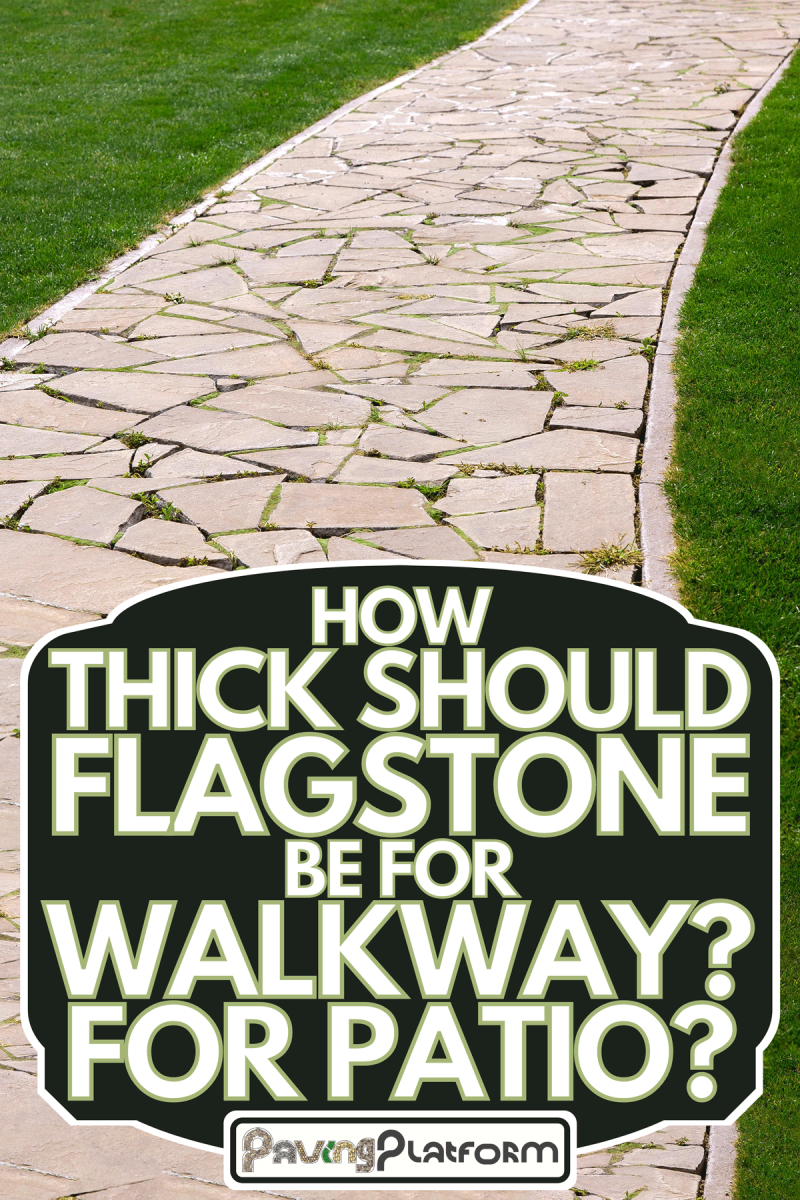
What are flagstones?
Flagstones are quarried sedimentary rocks. As pavers, they are large and flat slabs made of slate, limestone, or sandstone. They are one of the two basic types of stone pavers.
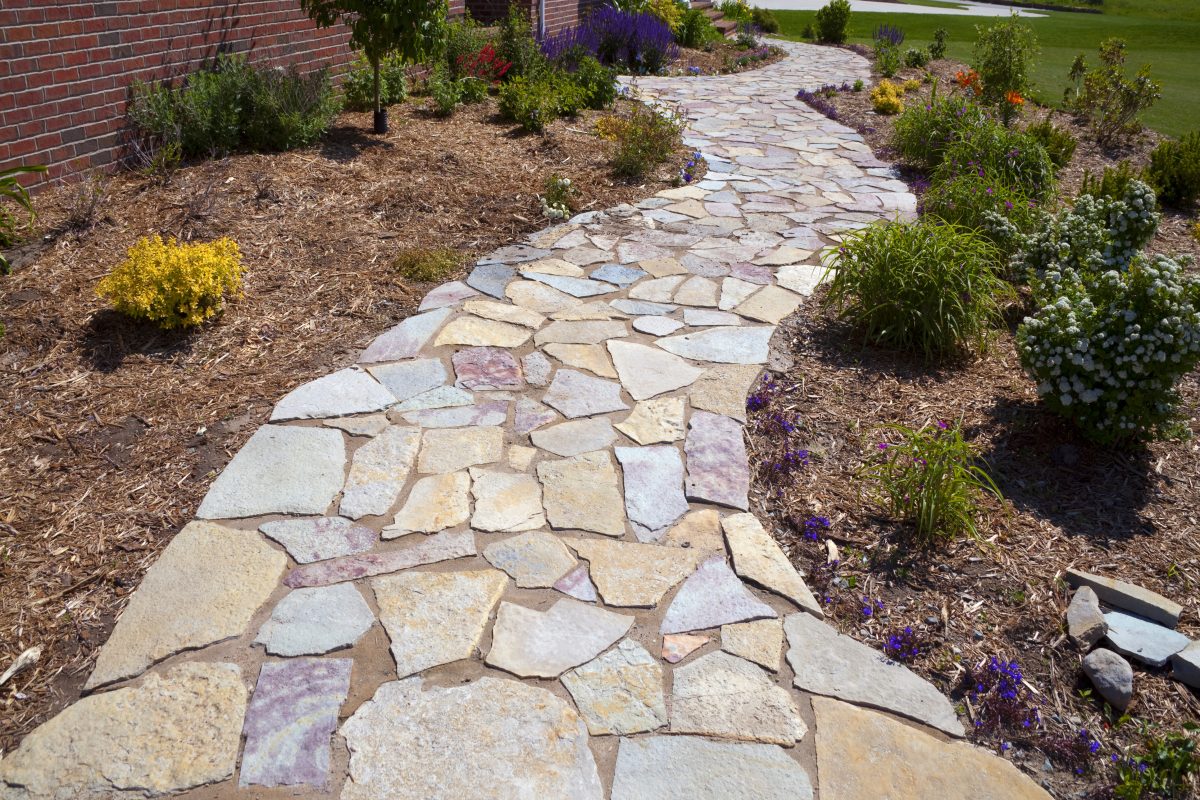
Being natural stones, they can be easily cut into different styles and sizes offering very unique patterns for hardscapes. More interestingly, minerals such as calcite, silica, or iron ore form flagstones together, causing their usual colors to be brown, blue, and red, or a combination of these hues.
The types of flagstones that are commonly available are slate, sandstone, and quartzite. They are most ideal for residential walkways, patios, and pool decks because of the following characteristics:
- versatility and easy installation
- acid and freeze-thaw resistance
- durability
- high density
- low maintenance
- traction
What is the best material to put under flagstones?
While flagstones are acid-resistant and can be directly laid on dirt, preparing a certain type of bed on which they will be installed is still essential for a long-lasting project. By efficiently putting either sand, stone dust, cement, or gravel under flagstones, you can ensure that your walkway or patio becomes stable and sturdy, rain or shine.
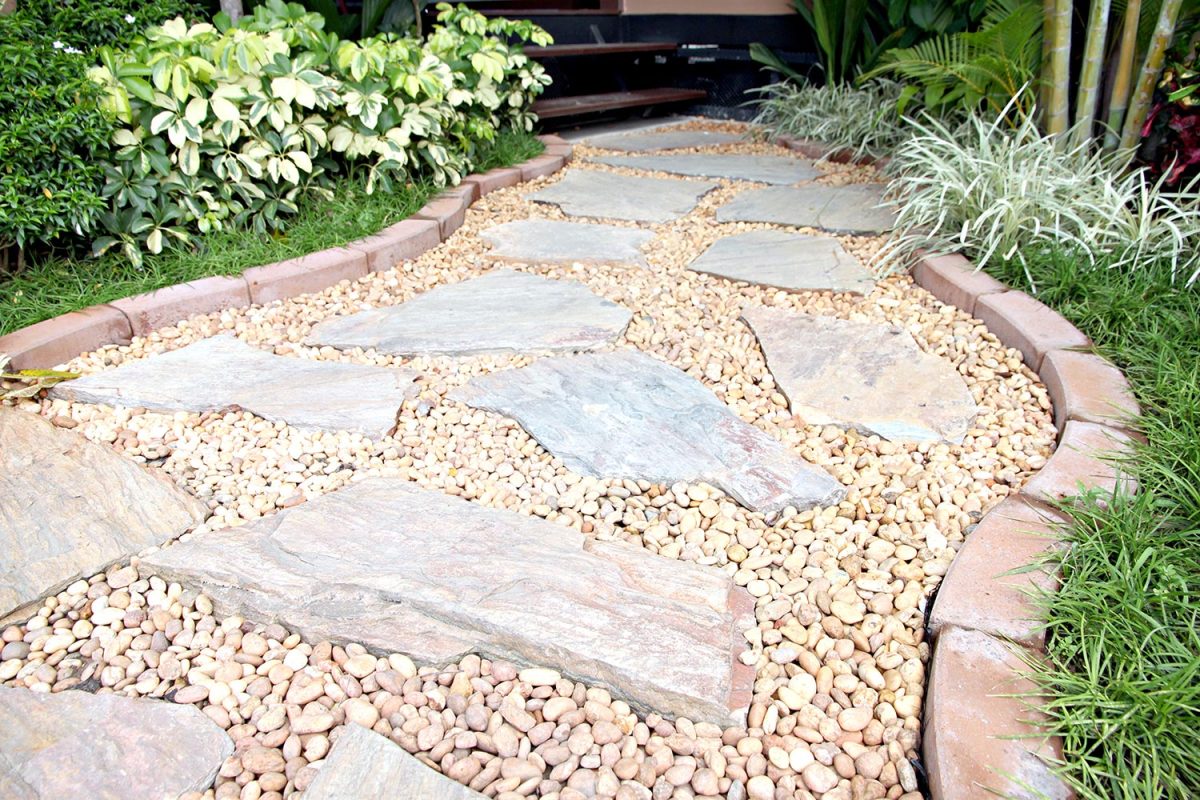
The type of bedding is also dependent on the thickness of the flagstones. Ideally, landscapers will put thin flagstones on a wet mortar on an existing concrete slab to prevent breakage due to heavy traffic.
Dry-laying flagstones in the sand can be a good and easy option as well. This is when flagstones are placed on a bed of sand and gravel. The recommended walkway or patio base must be at least 3-inches deep filled with compressed gravel and sand. Compacted gravel together with coarse sand ensures that any movement caused by water seepage or a freeze-thaw cycle is reduced, if not completely prevented.
Stone dust, also popularly known as quarry dust, grit, or decomposed granite, can be an alternative to put under flagstones; however, many professionals do not wholly trust this material instead of sand. Made from crushed stones, this can be poor at draining water and preventing pavers from shifting.
When all the flagstones, supported by a good subbase, are in place, apply either mortar, grout, or simply sand to fill in the seams and gaps.
Check this Thin-Set Mortar out on Amazon.
How to Install a Flagstone Walkway or Patio on Dirt
Building a flagstone walkway or patio can be daunting but with the right tools, materials, and workforce, it's doable in less than a day! First, prepare the following then head over to our five easy steps:
- wheelbarrow
- shovel
- rubber mallet, ordinary hammer, and hand tamper
- rake and broom
- flagstone (1.5 inches to 2 inches thickness)
- vinyl garden border or edging coil
- landscaping fabric (weed block material)
- sand
- gravel or pebbles
Step 1: Excavate the site and mark the walkway
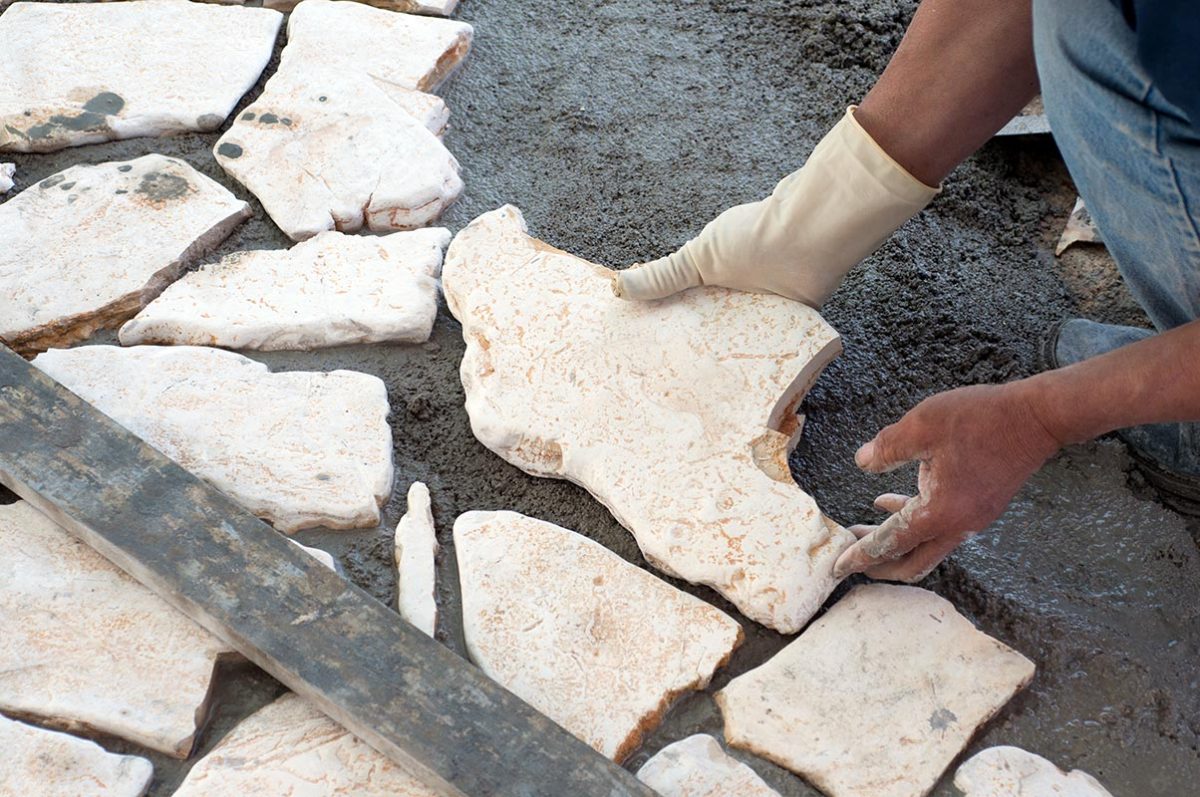
Decide on the dimension, shape, and direction of your walkway or patio. Using a rake, remove grass, rocks, big roots, or any debris that makes the ground uneven. Next, plot the pathway boundaries using landscaping paint (e.g., spray paint). This will guide you on where to put the vinyl garden border. The walkway width, in general, is 3 feet or wider.
Excavate the desired area. A typical flagstone has a width of 2 inches so you must dig into the soil to a depth of at least 5 inches.
Check this edging coil out on Amazon.
Step 2: Install the borders and weed block
Ensure that the excavated area is level and flat using a hand tamper. Using a hammer, install the border along the sides of the walkway. This will protect the sand and gravel from being washed away during the rainy season. Next, roll out a weed block on the flat and compacted ground.
Check out this best-selling weed block landcsape fabric on Amazon.
Step 3: Fill in the pathway with sand
Spread at least 2 inches of fine sand out on top of the weed block, covering the entire area. Using a hand tamper, tamp the sand down to ensure compaction.
Step 4: Lay the flagstone
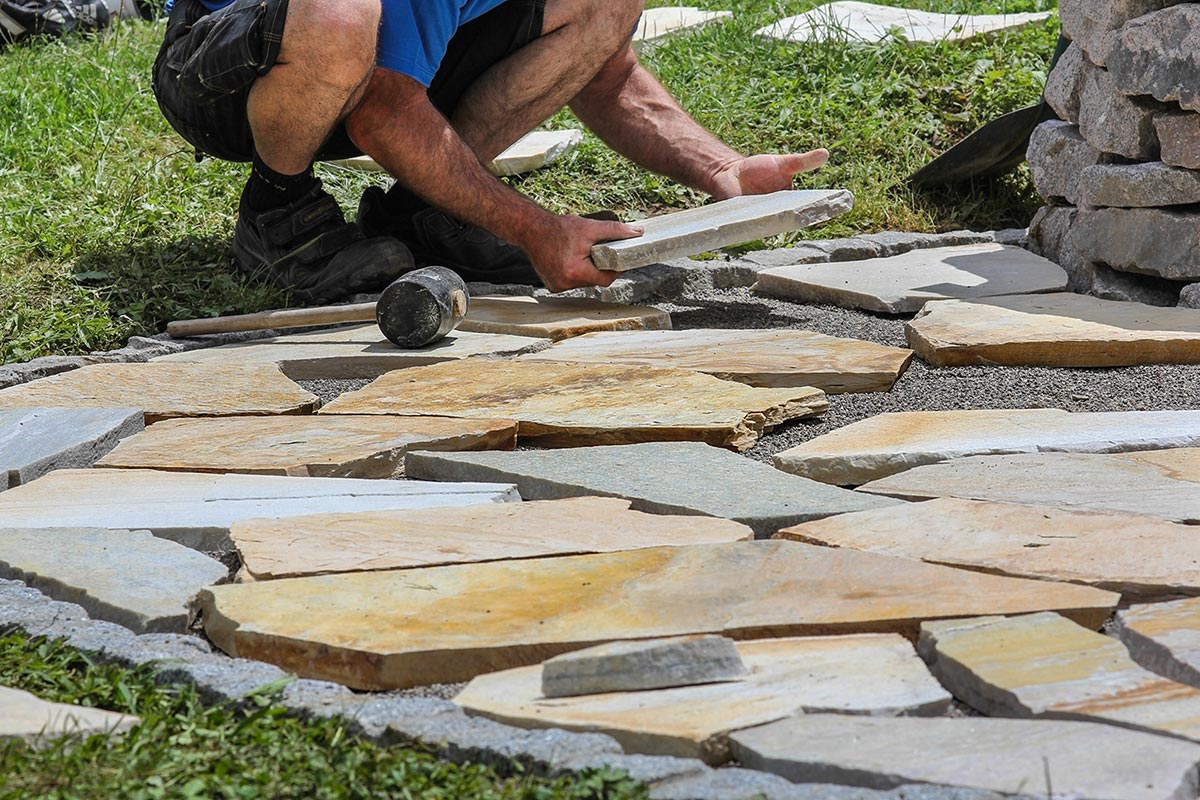
Based on your desired pattern, place the flagstones on top of the sand, beginning with the largest stones in the middle of the walkway. The recommended gaps between them are around 2 inches or 3 inches. Should you want to adjust the size of the stones, break them using a regular hammer. Tamp them down using a rubber mallet to make sure they are firmly nestled into the sand.
Water drainage is an integral part of paving. You may, therefore, choose to slightly elevate the middle part of the walkway to allow better runoff during the wet season.
Step 5: Add the pebbles or gravel
To finish, spread pebbles or gravel out to fill in the gaps with a broom. These gap fillers help keep the flagstones in place and provide better water drainage. Landscapers may also use mortar in between the flagstones for a stronger walkway. Should you choose to put mortar into the gaps, you will need to let the project dry for at least a day then seal it entirely using a quality stone sealant.
Using sand as fillers or dry lay is recommended for places where the weather is constantly changing from hot to cold. Dry lay is perfect for easy replacement or removal of flagstones. Mortar, on the other hand, is most ideal for permanent walkway or patio projects.
Are flagstones slippery when wet?
Generally, flagstones have a non-slip surface making them ideal for walkways, but when they get wet and covered with moss, algae, or lichen due to poor water drainage, they tend to be slippery. To lessen slipperiness, you will need to paint your flagstone pavers with non-slip paint.
A gritty additive can also be added to sealers to make these natural stones non-slip. Regular use of broom, bleach solution, and/or brush to get rid of moss can likewise prevent the cause of slipperiness.
Check this Anti-slip Paint Additive out on Amazon.
How Much Do Flagstone Walkways or Patios Cost?

Based on a national average according to Angi, a flagstone patio costs between $15 and $21 per square foot. The installation of a dry-laid flagstone patio is priced between $1,900 and $4,400 while a wet-laid one (i.e., mortared) costs between $2,700 to $7,000.
Click here to view this 2,000 lbs Patio Flagstone on Amazon.
Conclusion
In all projects, be it commercial or residential, the durability and versatility of the paving materials to use are of paramount importance. Knowing the right thickness, size, and type of flagstones will not only allow you to build safe and visually appealing walkways or patios but also save you plenty of money on maintenance. Like in our usual advice, do not hesitate to seek volunteers and professional assistance when initiating any home-improvement project!
If you find this article helpful, you might also want to see these equally informative posts from us:






![Vibrant Red Paver Stone Path, Can You Spray Paver Sealer? [How To Apply It]](https://pavingplatform.com/wp-content/uploads/2022/04/Vibrant-Red-Paver-Stone-Path-600x400.jpg)
![Properly laid out red pavers for a garden, Can You Tint Paver Sealer? [And How To]](https://pavingplatform.com/wp-content/uploads/2022/04/Properly-laid-out-red-pavers-for-a-garden-600x400.jpg)
